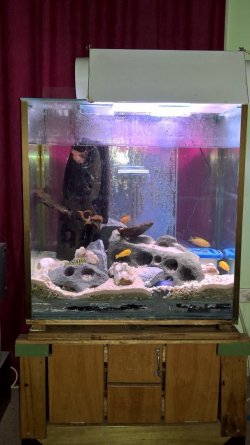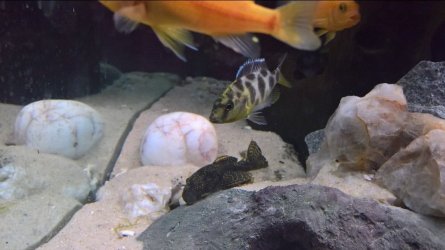I have two tanks one is about 200lt and the other is probably 140 they are both rescued tanks, the 140 I got from my sister the back smashed so I patched it up and siliconed in a picture to hide the patches. I enjoyed it so brought some more glass to add to some I had laying around and built the deep 200 litre .

I finished moving all my fish and a few new ones today Into the 200.
I have had these fish for 12 months now they are African chiclids. I have built a stump with an intense cave system in the first 1/2 foot of the tank , I imagine I could have at least 30 mbunas living in the system that only come out when I tap for food, in the morning or when I turn on the lights which, incredible spacious. I haven't put in any plants yet I have room for improvements and am open to suggestions.
My new fish I added today are 2 giraffe or venustus plus an extra electric yellow.

The yellow was to replace my other one ,because at first I only put in my 3 female blue zebra and non dominant kenyi male .they really loved it alone but became really aggressive with all the extra room . When I also add my electric yellow the day after he was attacked and drilled in the flanks, the second I put him in. he went and layed on the sand on his side and then hid and only came out later tonight , hooray.
I added the alpha blue zebra and new fish, altogether today and the former ,they have calmed again all is good the giraffes have found a spot in the sand the alpha zebra owns the under world ,at least till he finishes building his nest.
I keep the ph above 7.5 but my main goal is the low ppm and high carbonate hardness I need help with this I cant get it , I think I need to add a strong acid.
My lights are growlush 130 watt I can change colours if I want I don't use air or co2. My filter is home made I've got 1200 Lt/hr pump sucking into a internal sump and use filter mats with a fairly large space cut in the lid it moves a fair stream but you can't see the effect in the tank I guess it's probably moving a 10 cm sqr cube per second.
I have crushed coral over the caves and sand as well.
the other tank has guppies in it .and since it,s where my fish were housed I,s not decorated. I also have two 250 ltr water boilers with plants guppies and gold fish ,and crayfish out side.










I finished moving all my fish and a few new ones today Into the 200.
I have had these fish for 12 months now they are African chiclids. I have built a stump with an intense cave system in the first 1/2 foot of the tank , I imagine I could have at least 30 mbunas living in the system that only come out when I tap for food, in the morning or when I turn on the lights which, incredible spacious. I haven't put in any plants yet I have room for improvements and am open to suggestions.
My new fish I added today are 2 giraffe or venustus plus an extra electric yellow.

The yellow was to replace my other one ,because at first I only put in my 3 female blue zebra and non dominant kenyi male .they really loved it alone but became really aggressive with all the extra room . When I also add my electric yellow the day after he was attacked and drilled in the flanks, the second I put him in. he went and layed on the sand on his side and then hid and only came out later tonight , hooray.
I added the alpha blue zebra and new fish, altogether today and the former ,they have calmed again all is good the giraffes have found a spot in the sand the alpha zebra owns the under world ,at least till he finishes building his nest.
I keep the ph above 7.5 but my main goal is the low ppm and high carbonate hardness I need help with this I cant get it , I think I need to add a strong acid.
My lights are growlush 130 watt I can change colours if I want I don't use air or co2. My filter is home made I've got 1200 Lt/hr pump sucking into a internal sump and use filter mats with a fairly large space cut in the lid it moves a fair stream but you can't see the effect in the tank I guess it's probably moving a 10 cm sqr cube per second.
I have crushed coral over the caves and sand as well.
the other tank has guppies in it .and since it,s where my fish were housed I,s not decorated. I also have two 250 ltr water boilers with plants guppies and gold fish ,and crayfish out side.
Last edited:

